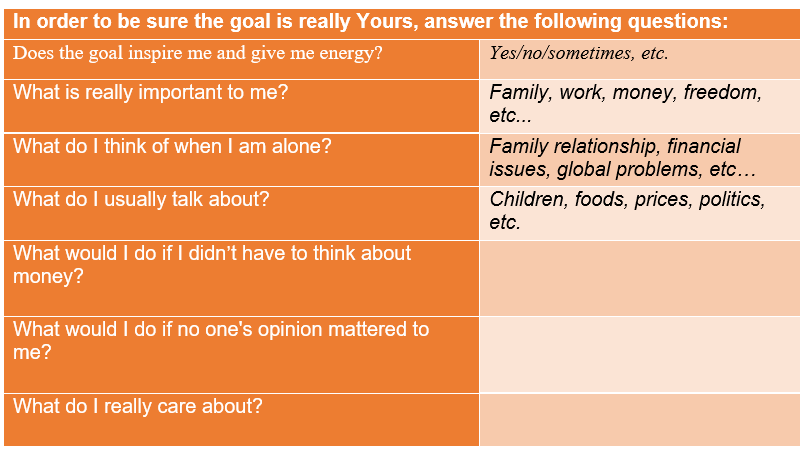Strategic planning: analysis and evaluation, creating solutions and projecting outcomes

To what extent does a person’s life, activities and decisions depend on himself? As much as he manages his own life properly, says dr. Janina Radvilė, PMP, Lithuanian couch and lector on management of individual’s life.
Despite numerous descriptions, strategic planning of personal career can be described as a process of sequential steps, during which
1) goals are set,
2) an action plan is drawn up to achieve those goals,
3) potential risks are anticipated/evaluated.
Strategic planning also envisages opportunities for adaptation to the changes, including changes in individual’s personal life, both national and worldwide economies, environmental or climate changes, etc.
Setting the right goals
According to the model developed by John Whitmore, the prominent leadership development and performance consultant, personal goals should be distinguished between final goals and performance goals. For example, a final goal might be ‘I want to find a job in a family-owned bakery’. A performance goal that helps to achieve this aim, for example, might be ‘I will be practicing baking / reading literature on baking for 2 hours every day’.
NOTA BENE: If a goal is unnatainable–there is no hope. If the goal is not challenging–it does not motivate.
When defining goals at work, in life, in family, you name it, reflection on the reasons behind those goals must be kept on a constant basis. Firstly, a question ‘WHY I have this goal’ should come, and other questions like ‘WHAT I have to do for this goal’ can only follow.As soon as a person’s goal is clear and he wants to achieve it, the brain subconsciously begins to organize the behavior so that the goal is achieved.
Activity
Title of the activity: Is the goal really yours?The aim of the activity: to figure out if the goal a person has established correlates with the 14 requirements of the John Whitmore model below.
Skills that the activity develops: self-analysis, creating solutions and projecting outcomes.
How many people the activity is suited for: at least 1.
Time requirement for the activity: up to 30 minutes.
How many instructors are needed: none.
Other requirements for the activity: calm and positive atmosphere for better focusing on the task without any interferences.
Describe the activity in a clear and concise manner:

After establishing a goal, check on whether it correlates with these 14 requirements in the John Whitmore model below.

After completing those two tables, keep on thinking the following:
- Goals must be YOURS (not those of your parents, spouse, teachers, etc.);
- Goals must match your values, and values must meet goals. Think about what is most important in your life;
- If goal contradicts personal values, a person feels stress, dissatisfaction, bitterness;
- If there are additional conditions, name them, e. g. I will start my family bakery after completion of vocational training;
- The goal must be at the limit of possibilities, i. e. not too small–otherwise it doesn’t motivate;
- Mention only the things you want to do yourself, i. e. I want to find a job instead of I don’t want to run out of money;
- Use the present tense, i. e. I do instead of I shall do;
- Use only positive expressions, i. e. I want to have a job instead of I do not want to be unemployed.
If the 14 steps are too complicated, keep in mind the following ground rule when establishing Your goal:

Activity
Title of the activity: Drawing an action plan
The aim of the activity: strategically planning of the professional/personal path; evaluation of personal motivation behind the goal; distinguishing the final goals and performance goals.
Skills that the activity develops: self-analysis, strategical planning, creating solutions and projecting outcomes.
How many people the activity is suited for: at least 1.
Time requirement for the activity: up to 30 minutes.
How many instructors are needed: none.
Other requirements for the activity: calm and positive atmosphere for better focusing on the task without any interferences.
Describe the activity in a clear and concise manner: The activity may be conducted in two ways–short and long one.
The short way is drawing up a short-term plan that helps in reaching personal goals. A person is more likely to succeed if his/her plan answers the 4 simple questions:

For some people, especially those who are so-called procrastinators or are unconfident about themselves, a long way, A Contract with Me Myself, can be a solution. Find the contract template below:

References
1. Janina Radvilė. Niekada nevėlu gyventi. Svajok. Planuok. Išdrįsk. Tyto alba, 2017.
2. Mikael Krogerus and Roman Tschappeler. The Decision Book. Fifty models for strategic thinking. Kein et Aber AG Zurich-Berlin, 2017.

